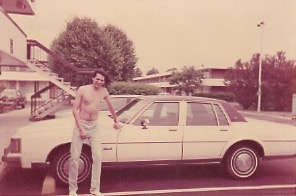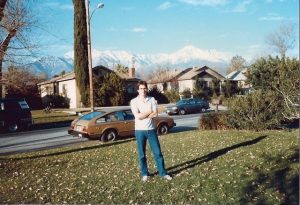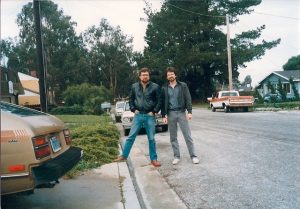
Here’s how the inspiration for this show went down through email.
John Carlton Thu, August 18, 2016 at 9:30PM
To: Kevin Rogers
Some ideas:
1) You don’t have to write your autobiography, but you do need to think about it. It’s a way of measuring how far you’ve come, what goals were worth it/not worth it, what went wrong/right, and what trajectory you’re on. Very important, trajectory. If you don’t adjust now, the next five years will probably be like the last five.
2) The rule for getting testimonials — go deeper when someone offers a platitude like “it’s great” — applies here. When interviewing old people, they also tend to give pat answers. “It was fine.” “I was scared.” “It was the happiest moment of my life.” Simple “why” questions bring up the story behind the platitude.
3) “Mirroring” (talk therapy tactic) someone’s speech also works to get at the deeper stories. “The birth of my daughter changed my life.” “It changed your life.” “Yes, in ways I never dreamed.” “In ways you never dreamed.” “Yes, I felt more alive, like I’d arrived…” etc
This also works with yourself. To start your autobiography (whether you actually follow through and write it or not), write out some questions. What was the high point of your life? The low point? When were you the most scared? The happiest? What were the turning points of your life?
More likely, having these questions segmented by age — childhood, youth, early adulthood, middle age, etc — gives you different answers. An autobiography of just these “high/low” points would pretty much describe anyone very well
4) Best tactic for an autobiography: Something I picked up from Steven Manning, who wrote “how to write a book on anything in 14 days”. Great guide. I wrote “Kickass” using his tactics — set up 20 chapters, each a main theme, plan on one supporting sub-theme per page, 10 pages (average) per chapter. 200 page book.
If the “theme” thing bothers you — and biographies that start with “I was born in Pomona on Saturday the 15th” will bore the shit out of anyone — then use another Manning tactic: Choose iconic objects.For me, some sample chapters are “couches I’ve slept on”… “cars I’ve owned”… “bands I was in”… etc. Quick way to get into the stories that define who we are. Couches, for example: I was sleeping on one, homeless, living out of my car, when I had my epiphany that began my career. I also got laid on, and behind, several others — which leads to who the women were, what the situation was, how I got there, what the consequences were. They played a role in my script.
Same with all the other iconic objects. I can’t explain the bands I’ve been in without describing the situation of my life around them — high school, college, middle age — and the people involved. It’s a great, easy way to come in the “side door” of telling your life’s story.
“Forced storytelling”, in a way. The natural first question after saying “couches played a role in my life” is “how?” What follows is your story
5) The trick is to find the hooks, the themes, the iconic moments and play off of them. Your life isn’t just a series of years slogging by (“when I was 17, I made the varsity basketball team”), but a series of tales that — when told right — involve drama, pathos, comedy, tragedy, all of it.
6) Finally… if your life truly is boring… why are you allowing this to happen? Shame on you.
Kevin Rogers Thu, August 18, 2016 at 10:04PM
To: John Carlton
Goddamn great stuff. What if, rather than just giving people an outline for how to write their biographies, we cover cars we’ve owned as an example.
We can each choose one and tell the short version of our life during the time of that car.
We can still explain the tactic to keep it specific to a writing lesson, but I think the real meat would be in the stories themselves.
What do you think?
John Carlton Fri, August 19, 2016 at 1:24AM
To: Kevin Rogers
Yup. Great call.
’62 Chevy Impala. Or the ugliest car ever made, my ’80 Celica GT 5-speed lift back. Cockpit like a spaceship… yeah, I’ll probably use that one… Though they’ve all got stories…
Kevin Rogers Fri, August 19, 2016 at 8:08AM
To: John Carlton
Excellent. This is gonna be good.
Got a photo with you and the Celica?
I’m going with the ’84 Delta 88. First proper “road car”. Who knew it was also the preferred sled of drug traffickers in the south? Lost count of how many German Shepherds sniffed that trunk.

John Carlton Fri, August 19, 2016 at 2:45PM
To: Kevin Rogers
Here are two shots — one good one of the car, with me. The other is my favorite, me and Zen Dawg up in San Luis Obispo, looking like hoods (or “Miami Vice”, as you once said when I posted it in the Gonk group). Either will do. Or, hell, both. Why not…


Resources
Gorbachev’s interview with Cal Fussman
Thanks for tuning in for another episode of Psych Insights for Modern Marketers…
![]() Remember, we created this podcast for YOU, so take a minute to leave a comment below to tell us what you think. John and Kevin both love to jump in and mix it up with our listeners…
Remember, we created this podcast for YOU, so take a minute to leave a comment below to tell us what you think. John and Kevin both love to jump in and mix it up with our listeners…
![]() As always – be sure to use the social sharing buttons below to share PI4MM.com with your friends and colleagues – we’re all on this ride together.
As always – be sure to use the social sharing buttons below to share PI4MM.com with your friends and colleagues – we’re all on this ride together.
![]() If you love the show (and let’s be honest, who doesn’t?) you can support us by subscribing and leaving a review on iTunes. We’ll keep doing them as long as you keep spreading the good word!
If you love the show (and let’s be honest, who doesn’t?) you can support us by subscribing and leaving a review on iTunes. We’ll keep doing them as long as you keep spreading the good word!
Every self-respecting Psych Insights listener should also…
Read deeply at John’s blog, “The Rant”.
Visit Kevin’s bustling new Community of Copywriters at CopyChief.com
Get signed up for news from show producer Brian McLeod’s ProductSpeed.com

Another killer one. This is inspiring my upcoming blog to rant and share about me, my old man, and who knows what other maniacal stuff.
The single idea to pick one object and just tell its history is worth millions. When you use it right, the copy becomes “real”. It’s not text anymore. It pops out of the screen and becomes a movie that we see in our heads.
Like when you put on 3d glasses in a movie theatre, and that blurry flickering transforms into the saber-toothed squirrel from Ice Age jumping straight in your face chasing its beloved acorn or whatever.
As authors we aim to give readers certain feelings.
Like, when we are selling and we are getting to the close – at that moment we want the reader to feel certainty.
“Yes, you will lose 10 pounds in the next 15 days with this diet program. But if by any reason it will not happen or if you are not satisfied in any other way, all you have to do is call this 800 number and I will give you all the money back no questions asked. You risk nothing except losing that nasty ass. Give me a break!”
↑ that was about certainty.
Anyway, we can’t make reader have a feeling by naming the feeling. “You must be certain right now that this is the program you should buy” – that’s just bullshit.
Don’t tell me how I must feel. Just persuade me or shut up.
When you tell me about the money back guarantee – you make me feel certainty, and i’m persuaded.
Okay, so basically it’s “show, don’t tell” principle.
You have to figure out how to “show” without telling. But it’s rarely easy. Sometimes, especially when you are tired, coming up with this tangible example to express your idea feels like banging your head against the doorjamb. Painful + you know that there should be an easier way…
…and NOW is the time to use the principle John and Kevin told us in this episode.
You just pick a thing and tell it’s story.
And it will turn out that the story has it all – the problem, the hero, the journey, the redemption, the proof and the tangible and realistic as shit reason to BUY NOW.
Like those pants I’m wearing right now, lying in my bedroom with the laptop on my chest, typing these words. They are two sizes bigger. The pants. That’s why I only wear them at home. Whenever I have to go to the kitchen to get some water, I only have one hand because the other is always occupied holding the waistband so the pants don’t fall down. But they used to be tight and so deep in my ass, that it was a problem to get them out at the end of the day. That’s how fat and gross I was. But then I got this diet program I’m telling you about. Long story short – I don’t have that hungry ass syndrome problem any more. Along with other benefits of being fit and healthy. So please just do yourself a favour and try this problem now, ESPECIALLY since I have that 90-day money-back no-questions-asked-guarantee… and there is your close.
I would say – that technique of telling a story of an object is a must-have for any situation when you don’t know what to write.
John, Kevin, thanks for the podcast.
By the way, through September I binge-listened to all the episodes except couple of the earliest ones that you did not upload to the iTunes.
Looking forward to the next episodes.
Peace 🙂
Hey John,
Have your ever considered having a dating/sex/relationship marketer like Chris “Mr.Money Fingers” Haadad on the podcast? Some of us folk fancy the marketing of libido driven goods and services. Hope that show will be coming soon…
Hey John, Kevin –
Strangely enough I was thinking about the word legacy a few months ago too. I was always enamored by the old letters soldiers would write to their wives in WWI or WWII on the battlefield, and started playing with the idea of having something to share with my future kids, grandkids, and everyone that comes across my life.
I’ve been volunteering at an animal rescue/shelter in the past year, and decided to start video blogging about it recently. Mostly because I really enjoy video, and I find it to be a much more powerful medium for capturing moments in life. Since our memories start to haze, it’s incredible looking even at old videos on your phone from a year ago on what you did.
The first goal with the vlog besides having fun, is to inspire other folks to also start volunteering. The second is having it be an ongoing body of work that my future (and current) family can use to keep up and know what my life was like. The final goal and perhaps most selfish: one day when I’m old and can’t remember anymore, I can look back on all these clips and experience what those moments were like again.
Like Joe Rogan once said, “Be the hero of your own movie” – we have amazing tools like Youtube and a smartphone now, so why not? If you got a minute to check out the channel, it’s here: https://www.youtube.com/channel/UCElabg7x-yIozN9WjiIJAew
Thanks guys and look forward to the next episode.
– Terry
Hilarious stories in here. Funniest ep so far!
Love the format of using cars and other touchstones to inspire a ‘road-less-travelled’ way of telling a story this way. The most entertaining biographies are always more thematically ordered with hooks, instead of just chronologically, right?
More please, guys.